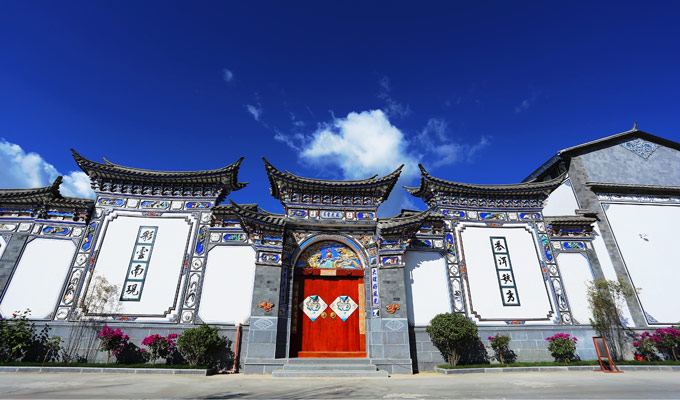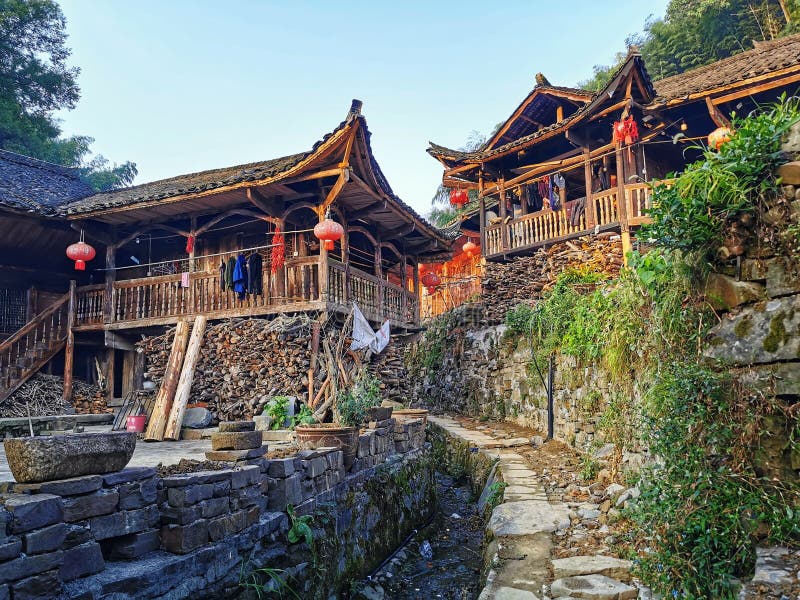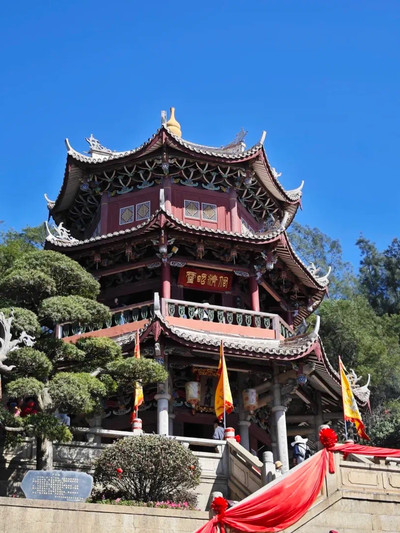The Bai People Ancestral Temple: A Cultural Gem in [Location]
![The Bai People Ancestral Temple: A Cultural Gem in [Location]](https://www.chinahistorytrip.com/wp-content/uploads/2025/09/bai-people-ancestral-temple-a-scenic-view-of-bai-people-ancestral-temple-8553-1024x768.jpg)
An Essential Guide to Visiting Bai People Ancestral Temple
Nestled in the scenic landscapes of Yunnan Province, the Bai People Ancestral Temple stands as a testament to the rich cultural heritage and history of the Bai ethnic group, one of China’s largest and most vibrant minorities. This sacred site, often overshadowed by the breathtaking views of Erhai Lake and the majestic Cang Mountain, invites international travelers to delve deeper into the traditions, beliefs, and ancestral reverence of the Bai people.
As you approach the temple, you’ll be welcomed by stunning architectural designs infused with elements that reflect the Bai’s unique identity. The temple not only serves as a place of worship but also as a cultural hub where stories of resilience, history, and artistry come alive. Here, the Bai people honor their ancestors, celebrating a legacy that dates back over two millennia, marked by vibrant festivals, traditional music, and intricate craftsmanship.
Visiting the Bai People Ancestral Temple offers more than just a spiritual experience; it is an opportunity to connect with the local community, understand their customs, and appreciate their way of life. Whether you are wandering through its ornate halls, participating in a local festival, or engaging with the friendly Bai residents, this destination promises an enriching journey that transcends mere sightseeing. Prepare to be captivated by the stories etched within these walls, and let the spirit of the Bai people resonate with you as you explore this cultural gem in the heart of Yunnan.
In This Guide
- An Essential Guide to Visiting Bai People Ancestral Temple
- The Rich History and Legends of Bai People Ancestral Temple
- Main Highlights: What You Absolutely Can’t Miss
- Planning Your Visit: A Practical Guide
- Tickets: Prices, Booking, and Tips
- How to Get There: A Complete Transportation Guide
- Local Cuisine and Accommodation Nearby
- Frequently Asked Questions
- Final Thoughts on Your Trip
The Rich History and Legends of Bai People Ancestral Temple
Nestled in the heart of Yunnan Province, the Bai People Ancestral Temple is not merely an architectural marvel; it is a vibrant testament to the rich tapestry of history, culture, and legend that defines the Bai ethnic group. The Bai, one of China’s largest and most prosperous minorities, have a history that stretches back over two millennia, intricately woven into the very fabric of Dali, their cultural epicenter.
The temple itself serves as a spiritual sanctuary and a historical repository, echoing the tales of the Bai’s origins and their enduring legacy. The Bai people, known for their distinctive white clothing which symbolizes purity and peace, trace their lineage back to the ancient Qiang tribes, who inhabited the region thousands of years ago. It is believed that the Bai were originally called “Bo,” a name that gradually evolved to “Bai,” reflecting the cultural transitions and the influences from the Han Dynasty.
Historically, the Bai people thrived in the Dali area, establishing the powerful Nanzhao Kingdom in the 7th century. This kingdom flourished as a hub of trade connecting China, Burma, and India, and its rulers actively engaged with the Tang Dynasty, further embedding the Bai in the annals of Chinese history. The Ancestral Temple stands as a monument to this glorious past, where generations of Bai have gathered to pay homage to their ancestors, seeking blessings and guidance.
Legends abound within the temple walls, intertwining with the Bai’s historical narrative. One such tale speaks of the origins of the Bai people, suggesting they descended from the ancient Ji kingdom, which once flourished along the Yellow River. This connection to ancient civilizations not only enriches the temple’s significance but also highlights the Bai’s deep-rooted cultural heritage.
The architectural style of the Bai People Ancestral Temple reflects the unique blend of Han Chinese elements and the indigenous Bai aesthetic. Its intricately carved wooden beams, vibrant murals, and serene courtyard invite visitors to step back in time, offering a glimpse into the spiritual and communal life of the Bai people. Festivals celebrated at the temple, such as the Three Temples Pilgrimage, showcase traditional Bai music, dance, and rituals that have been preserved for generations, fostering a sense of identity and continuity among the community.
As international travelers explore the temple, they are not just witnessing a physical structure; they are engaging with a living history, one that speaks of resilience, cultural pride, and the enduring spirit of the Bai people. The Bai People Ancestral Temple is a gateway into the past, a place where history and legend converge, inviting all who visit to reflect on the intricate stories that have shaped this remarkable ethnic group.

Bai People Ancestral Temple.
Main Highlights: What You Absolutely Can’t Miss
Visiting the Bai People Ancestral Temple (白族宗祠) offers an enriching experience steeped in history and culture, making it a must-see for travelers exploring Yunnan Province. Here are the key highlights you absolutely cannot miss:
1. Architectural Marvel
The Bai People Ancestral Temple is not just a place of worship; it’s a stunning example of Bai architecture. The temple features intricate wooden carvings, elegant roof designs, and vibrant murals that depict the rich history and folklore of the Bai people. Pay special attention to the detailed craftsmanship that reflects traditional Bai aesthetics and their connection to nature, often incorporating elements like flowers, birds, and mythical creatures.
2. Cultural Significance
This temple serves as a vital cultural hub for the Bai community, where ancestral worship plays a crucial role in their traditions. Engage with local practitioners to learn about the significance of ancestral rites and the rituals performed here. This is a unique opportunity to gain insights into the spiritual life and customs of one of China’s largest ethnic minorities.
3. Festivals and Celebrations
If your visit coincides with one of the Bai festivals, you’re in for a treat! Events like the Torch Festival and the Three Temples Pilgrimage are celebrated with great fervor at the temple. These festivals feature traditional music, dance performances, and colorful processions, showcasing the vibrant cultural heritage of the Bai people. Attending a festival will immerse you in the lively spirit and communal bonds of the Bai community.
4. Local Artisans and Crafts
Adjacent to the temple, you may find local artisans showcasing their crafts. From intricate tie-dye textiles to exquisite pottery and silver jewelry, the craftsmanship of the Bai people is remarkable. Take the time to browse their creations, and perhaps bring home a piece of Bai culture as a souvenir.
5. Scenic Surroundings
Nestled near the picturesque Erhai Lake and shadowed by the majestic Cang Mountain, the temple’s location is breathtaking. After exploring the temple, take a leisurely stroll around the area to enjoy the stunning natural landscapes. The serene views provide a perfect backdrop for reflection and photography.
6. Historical Context
To truly appreciate the temple, delve into the history of the Bai people and their ancestors. The temple is a testament to the resilience and heritage of a group that has thrived in this region for centuries. Understanding the Bai’s historical struggles and achievements enriches your visit and connects you more deeply with the site.
7. Guided Tours
Consider joining a guided tour offered by local experts. These knowledgeable guides can provide context and stories that enhance your understanding of the temple’s significance and the Bai culture. They often share personal anecdotes that bring the history to life in a way that enriches your visit.
Conclusion
A visit to the Bai People Ancestral Temple is more than a sightseeing stop; it’s an encounter with the cultural heart of the Bai minority. From its stunning architecture to its vibrant community practices, this temple invites you to explore the tapestry of traditions that define the Bai people. Don’t miss the chance to immerse yourself in this unique cultural experience during your travels in Yunnan.

Bai People Ancestral Temple.
Planning Your Visit: A Practical Guide
Visiting the Bai People Ancestral Temple offers a unique opportunity to immerse yourself in the rich cultural heritage of the Bai ethnic group, one of the largest and most prosperous minorities in China. Nestled in the picturesque landscapes of Dali, Yunnan Province, this sacred site is not just a monument; it is a reflection of the Bai people’s history, beliefs, and traditions. To ensure a fulfilling experience, here’s a practical guide to help you plan your visit.
Getting There
Location: The Bai People Ancestral Temple is located in Dali, Yunnan Province, a city renowned for its stunning natural beauty and historical significance.
Transportation:
– By Air: The nearest airport is Dali Airport, which offers flights from major cities like Kunming and Chengdu. From the airport, you can take a taxi or arrange for a shuttle to Dali city center.
– By Train: Dali has a railway station with connections to various cities in Yunnan. Once you arrive in Dali, local buses and taxis are readily available to take you to the temple.
– By Bus: Long-distance buses from larger cities like Kunming frequently travel to Dali.
Opening Hours and Admission
- Opening Hours: The temple is generally open from 8:00 AM to 6:00 PM, but it’s advisable to check for any seasonal changes or special events that might affect these hours.
- Admission Fee: There may be a nominal entry fee to help maintain the site. It’s best to carry some cash for this purpose.
Best Time to Visit
The ideal time to visit Dali, including the Bai People Ancestral Temple, is during the spring (March to May) and autumn (September to November) months. The weather is mild and pleasant during these seasons, making it perfect for exploring the temple and the surrounding areas. Avoiding the rainy season (June to August) is recommended if you prefer dry weather.
What to Expect
The Bai People Ancestral Temple is not just a place of worship but a cultural hub where visitors can learn about the Bai people’s customs, beliefs, and artistic expressions. Here are some highlights to look forward to:
- Architectural Beauty: The temple features traditional Bai architecture, including intricately carved wooden beams and colorful murals that depict Bai legends and folklore.
- Cultural Exhibitions: You might encounter displays showcasing Bai traditional clothing, handicrafts, and artwork. Engage with local artisans and learn about their craft.
- Festivals and Events: If your visit coincides with Bai festivals, such as the Torch Festival or the Dali Three Temples Pilgrimage, you’ll have the chance to witness vibrant celebrations filled with music, dance, and traditional rituals.
Cultural Etiquette
When visiting the temple, it’s important to respect the local customs and traditions:
– Dress Appropriately: Although there may not be strict dress codes, wearing modest clothing is always appreciated.
– Photography: Always ask for permission before taking photographs of people, especially during rituals or ceremonies.
– Quiet Respect: Maintain a respectful demeanor within the temple, as it is a place of worship.
Nearby Attractions
While in Dali, take advantage of your visit by exploring other nearby attractions:
– Erhai Lake: A stunning freshwater lake known for its scenic views and opportunities for boating or cycling along the shores.
– Cang Mountain: A majestic mountain range offering hiking trails and breathtaking vistas of the surrounding countryside.
– Dali Ancient Town: Wander through the cobblestone streets, visit local markets, and enjoy the unique Bai cuisine at quaint restaurants.
Local Cuisine
No visit to the Bai People Ancestral Temple would be complete without sampling the local Bai cuisine. Don’t miss trying:
– Dali’s Famous Rice Noodles: Enjoy a bowl of flavorful rice noodles served in a rich broth, often accompanied by fresh vegetables and spices.
– Bai-style Barbecued Fish: Freshly caught fish from Erhai Lake, seasoned and grilled to perfection.
– Three Courses of Tea: A traditional Bai tea ceremony that showcases different flavors and brewing techniques.
By following this guide, your visit to the Bai People Ancestral Temple can be a meaningful and enriching experience, allowing you to connect with the vibrant culture and history of the Bai people in the stunning backdrop of Dali, Yunnan. Enjoy your journey!

Bai People Ancestral Temple.
Tickets: Prices, Booking, and Tips
Visiting the Bai People Ancestral Temple is a journey into the rich heritage of the Bai minority in Yunnan Province. As you plan your visit, here’s everything you need to know about ticket prices, booking, and tips to enhance your experience.
Ticket Prices
Entry to the Bai People Ancestral Temple typically costs around 30 to 50 RMB (approximately $5 to $8 USD). Prices may vary depending on whether you are visiting during peak tourist seasons or special events, so it’s always a good idea to check for any updates before your visit.
Booking Tickets
Tickets can be purchased directly at the entrance of the temple. However, to save time, especially during busy periods, consider booking your tickets in advance through popular travel platforms or local tour operators. Some tours may include the temple visit as part of a broader itinerary exploring Dali, which could offer additional insights into the Bai culture.
Tips for Your Visit
-
Best Time to Visit: The temple is open year-round, but the ideal time to explore is during the spring and autumn months (April to June and September to November) when the weather is pleasant and the surrounding landscapes are at their most stunning.
-
Guided Tours: Consider joining a guided tour for a more enriching experience. Local guides can provide in-depth knowledge about the temple’s history, architecture, and the significance of the rituals performed there.
-
Respect Local Customs: When visiting the temple, dress modestly and be respectful of the customs and practices observed by the Bai people. Photography may be restricted in certain areas, so be sure to ask for permission.
-
Explore the Surroundings: After visiting the temple, take some time to explore the beautiful landscapes of Dali, including the nearby Erhai Lake and Cang Mountain. The area is rich in natural beauty and cultural experiences that complement your temple visit.
-
Cultural Events: If possible, time your visit to coincide with local festivals or ceremonies. These events provide a unique glimpse into the vibrant traditions of the Bai people and enhance your understanding of their cultural heritage.
With these tips in mind, you’re set to immerse yourself in the cultural tapestry of the Bai people at their ancestral temple. Enjoy your journey!
How to Get There: A Complete Transportation Guide
To reach the Bai People Ancestral Temple, nestled in the heart of Dali, Yunnan Province, travelers can enjoy a variety of transportation options that cater to different preferences and budgets. Here’s a comprehensive guide to help you navigate your journey to this culturally rich destination.
Getting to Dali
By Air:
The nearest airport to the Bai People Ancestral Temple is Dali Airport (DLU), which is approximately 28 kilometers from the city center. There are direct flights from major Chinese cities like Beijing, Shanghai, and Kunming. Once you arrive at Dali Airport, you can take a taxi or shuttle bus to downtown Dali.
By Train:
Dali is well-connected by rail, with the Dali Railway Station located about 15 kilometers from the city center. High-speed trains from Kunming to Dali run frequently, making the journey a scenic and comfortable option. The train ride takes around two to three hours. From the station, you can easily find taxis or public buses to take you to your hotel or directly to the temple.
By Bus:
Long-distance buses are a cost-effective way to reach Dali from nearby cities, including Kunming and Lijiang. The bus journey from Kunming to Dali takes roughly 6 to 7 hours. Buses arrive at Dali’s main bus station, from where you can take a taxi or local transport to the Bai People Ancestral Temple.
Local Transportation in Dali
Once you arrive in Dali, getting around the city is relatively straightforward.
Taxis:
Taxis are widely available and are a convenient way to get around. Ensure that the driver uses the meter or agree on a fare beforehand. The Bai People Ancestral Temple is a well-known landmark, making it easy for drivers to locate.
Public Buses:
Dali has an extensive bus network that is both affordable and efficient. Look for buses heading toward the Old Town or Erhai Lake, as these typically stop near the temple. Keep in mind that signage may primarily be in Chinese, so having the destination written down can be helpful.
Bicycles and Electric Scooters:
For the adventurous traveler, renting a bicycle or an electric scooter allows you to explore Dali and its beautiful surroundings at your own pace. Many rental shops offer these options, and cycling is a popular way to experience the scenic beauty of the area.
Walking:
If you are staying in the Old Town area, walking to the Bai People Ancestral Temple can be a delightful experience. The temple is approximately 3 kilometers from the Old Town, and the walk offers stunning views of the landscape and local architecture.
Visiting the Bai People Ancestral Temple
Once you’ve made your way to the temple, you’ll be greeted by a stunning example of Bai architecture, rich in cultural significance. The temple is often open for visitors, but checking the hours and any entry requirements beforehand is advisable.
Tips for a Smooth Journey
- Language Barrier: While some locals may speak English, having a translation app or a phrasebook can be helpful, especially in more rural areas.
- Cash is King: Although credit cards are becoming more accepted, it’s advisable to carry cash, as many local vendors and smaller establishments may not accept cards.
- Respect Local Customs: The Bai People have rich cultural traditions. Be mindful of local customs, especially when visiting sacred sites like the Ancestral Temple.
With this transportation guide, you are now equipped to embark on your journey to the Bai People Ancestral Temple. Enjoy your exploration of this vibrant cultural heritage site!

Bai People Ancestral Temple.
Local Cuisine and Accommodation Nearby
Nestled in the scenic region of Dali, the Bai People Ancestral Temple offers not only a glimpse into the rich heritage of the Bai minority but also serves as a gateway to experience the delightful local cuisine and comfortable accommodations nearby.
Local Cuisine
The Bai people are celebrated for their vibrant culinary traditions, which incorporate fresh ingredients sourced from the lush landscapes surrounding Dali. As you explore the area, be sure to indulge in some of these local specialties:
-
Bai-style Roast Duck (白族烤鸭): Known for its crisp skin and tender meat, this dish is a must-try. Many local restaurants offer their unique takes on this classic, often marinated with a blend of local herbs and spices.
-
Erhai Fish (洱海鱼): Freshly caught from the nearby Erhai Lake, this fish is usually steamed or grilled, served with a zesty sauce that highlights its delicate flavor.
-
Three Courses of Rice (三道米): A traditional Bai dish, this consists of rice served in three different forms: plain rice, rice mixed with vegetables, and rice cooked with meats or fish. It’s a hearty meal that embodies the Bai’s agricultural lifestyle.
-
Bai-style Grilled Cheese (白族烧奶酪): A unique local delicacy, this grilled cheese is made from fresh, local dairy and is often enjoyed as a savory snack or appetizer.
-
Local Wine (白族米酒): Don’t miss out on sampling the Bai’s traditional rice wine, which is often sweet and slightly fizzy. It pairs beautifully with the region’s rich flavors.
Accommodation Nearby
After a day of exploring the Bai People Ancestral Temple and sampling the delectable local cuisine, unwind in one of the nearby accommodations that offer a blend of comfort and cultural authenticity:
-
Dali Ancient Town Boutique Hotel: Located just a short distance from the temple, this charming hotel features traditional Bai architecture with modern amenities. Enjoy stunning views of the Cangshan Mountains and the tranquility of the ancient town.
-
Erhai Lakeview Homestay: Embrace the local lifestyle by staying in a cozy homestay overlooking Erhai Lake. Enjoy warm hospitality and home-cooked meals made from family recipes for an immersive experience.
-
Bai Ethnic Culture Hotel: This hotel is designed to reflect Bai culture with its traditional decor and layout. Guests can enjoy cultural performances and workshops during their stay, making it a perfect option for those looking to delve deeper into Bai traditions.
-
Yunxiu Hotel: Situated near the temple and local markets, this hotel offers a blend of comfort and convenience. Its spacious rooms and friendly staff make it an excellent choice for families or group travelers.
Whether you’re savoring the flavors of Bai cuisine or resting in a culturally rich accommodation, your visit to the Bai People Ancestral Temple will surely be a memorable journey that connects you with the heart and soul of this enchanting region.

Bai People Ancestral Temple.
Frequently Asked Questions
Frequently Asked Questions about the Bai People Ancestral Temple
1. Where is the Bai People Ancestral Temple located?
The Bai People Ancestral Temple is situated in Dali, Yunnan Province, China. Nestled at the foot of the majestic Cang Mountain and near the scenic Erhai Lake, it offers stunning views and a deep connection to the Bai culture.
2. What is the significance of the Bai People Ancestral Temple?
The temple is a vital cultural and spiritual site for the Bai ethnic group, serving as a place of worship and ancestral veneration. It reflects the rich history and traditions of the Bai people, showcasing their unique customs and values.
3. What can visitors expect to see at the temple?
Visitors can explore intricately designed architecture featuring traditional Bai elements, beautiful carvings, and altars dedicated to ancestors. The temple often hosts traditional ceremonies and festivals, providing an authentic glimpse into Bai culture.
4. Are there any specific customs or etiquette visitors should be aware of?
Yes, when visiting the temple, it is respectful to dress modestly and behave quietly. Photography may be restricted in certain areas, so it’s best to ask for permission before capturing images, especially during ceremonies.
5. Is there an entrance fee to visit the Bai People Ancestral Temple?
Typically, the temple does not charge an entrance fee, making it accessible for all travelers. However, donations are often appreciated to support the preservation of the site.
6. Can visitors participate in any cultural activities at the temple?
Depending on the time of year, visitors may have the opportunity to partake in local festivals, ceremonies, or workshops, such as traditional Bai music and dance performances. It’s advisable to check the temple’s schedule in advance.
7. What is the best time to visit the Bai People Ancestral Temple?
The ideal time to visit is during spring (March to May) and autumn (September to November) when the weather is pleasant, and various cultural festivals take place, allowing for a more enriching experience.
8. How can travelers reach the Bai People Ancestral Temple?
The temple is easily accessible from Dali City by public transportation, taxis, or even on foot, depending on your location. Local tour operators also offer guided tours that include the temple as part of a broader exploration of Bai culture and Dali’s scenic beauty.
Final Thoughts on Your Trip
As your journey through the heart of Bai culture comes to a close, the Bai People Ancestral Temple stands not just as a monument of history, but as a living testament to the resilience, artistry, and spirituality of an ethnic group that has thrived for centuries in the breathtaking landscapes of Yunnan. Here, amidst the towering Cang Mountains and the serene Erhai Lake, you have glimpsed a world where tradition intertwines with everyday life, a place where ancestral worship is a cherished practice that fosters community and continuity.
Reflecting on your visit, consider the profound stories etched into the very walls of the temple, each carving and inscription whispering the legacy of the Bai people. The warmth of their hospitality, the vibrancy of their festivals, and the elegance of their unique architectural styles are but a few threads woven into the rich tapestry of their identity.
As you leave this sacred space, carry with you not just memories, but a deeper understanding of the Bai’s complex history and their enduring connection to the land they call home. Whether you’re inspired to explore more about their customs, delve into their arts, or simply appreciate the harmonious balance of nature and culture, the Bai People Ancestral Temple is sure to remain a cherished chapter in your travel story. Each visit invites you to not just observe, but to connect, to learn, and to celebrate the beauty of diversity in our global community. Safe travels, and may your adventures continue to inspire and enlighten you.